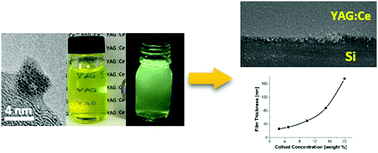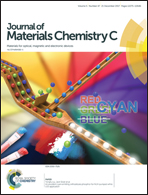Highly luminescent YAG:Ce ultra-small nanocrystals, from stable dispersions to thin films†
Abstract
The synthesis of well-defined oxide nanocrystals (NCs) with high crystallinity and ultra-small size (typically below 5 nm) is extremely challenging in view of their numerous important related applications. Often the obtained products suffer from particle aggregation, hindering beneficial advantages of nano-size character such as low light scattering properties. Solvothermal methods are very powerful synthetic approaches toward such nanocrystals especially when polyols are used as solvents. Their unique properties and gradual changes in a homologous series of polyols provide a wide range of tools for reaction design. A prominent example of such a reaction is the glycothermal synthesis of Y3Al5O12 (YAG) in 1,4-butanediol in which 20 nm aggregated nanoparticles can be obtained. Herein, we introduce a key evolution of YAG:Ce nanoparticles prepared via a modified glycothermal approach. We emphasize the crucial role of the co-solvent together with the amount of water. Addition of DEG and dehydration of precursors lead to 4 nm non-aggregated nanocrystals with high crystallinity and the correspondingly high photoluminescence emission. Very clear and stable colloidal solutions with concentrations of nanocrystals up to 50% are obtained. The prepared colloids are directly used for the fabrication of homogenous, luminescent and crack-free thin films without the addition of any plasticisers or surfactants. The thickness of the films is simply and efficiently controlled by the concentration of the colloidal solution.



 Please wait while we load your content...
Please wait while we load your content...